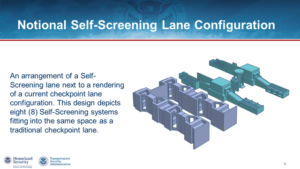The Department of Homeland Security in February plans to hold an industry day to further explore potential plans with vendors of concepts and capabilities to enable travelers to screen themselves at airport checkpoints to improve security while allowing passengers to have an independent screening experience.
The announcement of the Feb. 12 industry day was combined with a draft statement of work outlining a potential contractor development effort for the Passenger Self-Screening solution, a new Request for Information (RFI) seeking industry feedback on the feasibility and capabilities necessary for the project, and a Power Point slide deck showing notional self-screening security systems and configurations.
The Passenger Self-Screening effort is being led by the DHS Science and Technology (S&T) Directorate under its Apex Screening at Speed program, which issued an initial RFI last November soliciting potential solutions for passengers to screen themselves for weapons and explosives under their clothing while they divest their carry-on items at the checkpoint to save time and enhance their experience.
The Science and Technology division is working with the Transportation Security Administration’s Innovation Task Force (ITF) on the self-screening effort. The ITF works with vendors to identify emerging solutions and demonstrates them in operational settings to better understand how well they work and generate requirements. Examples include Automated Security Lanes that are located at around 130 airport checkpoint security lanes and advanced body scanners.
The draft statement of work issued by DHS on Monday includes a potential project timeline that begins with an award this October leading to possible prototype fabrications and testing out to early 2025.
The RFI includes technical topic areas for industry to consider, including video analytics to ensure people are following the correct screening protocols, passenger imaging systems and related detection algorithms, a metal detection system, and a property imaging system and related algorithms.
The notional self-service screening renderings provided by S&T and TSA all appear to be private areas for passengers to divest their carry-on luggage while at the same time they either are being screened by metal detection and imaging systems or can immediately screen themselves with these systems after divesting their property.
“A successful solution would lead to a passenger friendly, intuitive screening process while improving security, accelerating passenger throughput, and reducing pat-down rates,” the draft work statement says. It adds that “This effort seeks to develop a comprehensive screening solution capable of utilizing the natural motion of the divesting passenger to achieve thorough inspection for concealed items and provide near real-time feedback to the passenger if additional divestiture is necessary. The passenger will only be allowed to leave the divestiture station if they have been cleared by this solution.”
The Passenger Self-Screening effort, at least initially, is focused on solutions for the TSA PreCheck trusted-traveler screening lanes. The PreCheck population consists of travelers who voluntarily share personal information and biometrics to enable continuous vetting to ensure they are unlikely to represent a threat to the air transportation system. In return, these travelers receive benefits such as being allowed to leave their shoes on and laptops and liquids inside their bags to expedite the screening process.
